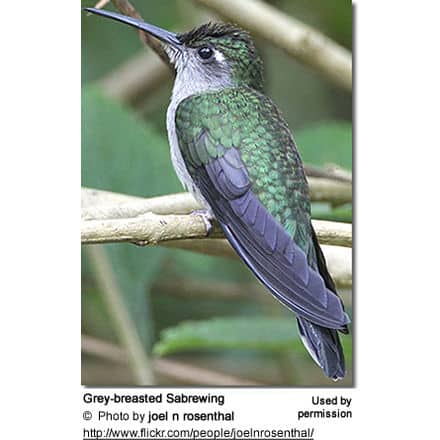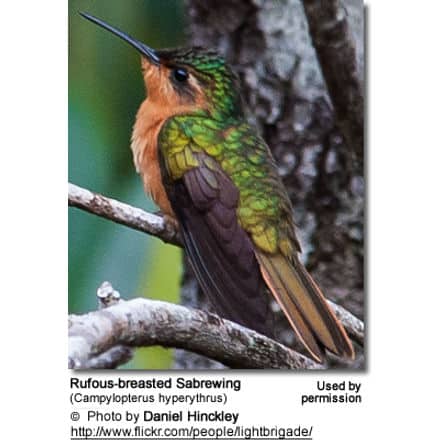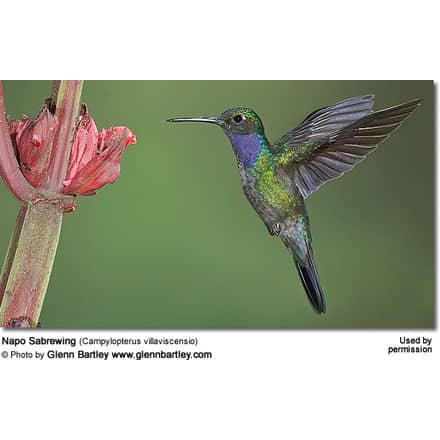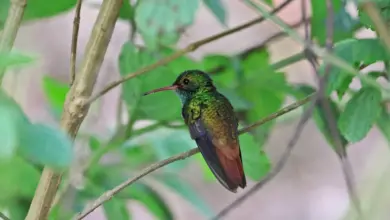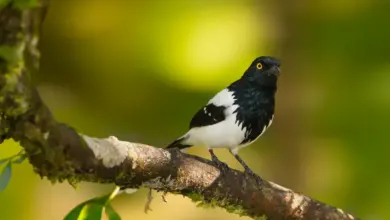Sabrewings (Campylopterus) – Hummingbirds
Hummingbird Information
The Sabrewings (Campylopterus) are relatively large hummingbirds that mostly occur naturally in Central and South America (some in Mexico); where they are usually found in the understory and along forest edges – mostly in mountains and near streams.
They specifically occur in the following countries: Mexico, Central America, Tobago, Venezuela, Guiana, Northern Brazil, Colombia, Ecuador and Peru.
Description
They are very large compared to other hummingbirds that typically measure 4.7 – 6 inches or 12-15 cm in length.
They were named for their long, sabre-like outermost primary flight feathers, which are thickened, flattened and bent at an angle.. In several species, the three outer pairs of tail feathers have broad white tips.
Their black, strong bill are slightly down-curved.
In some species, males and females look alike; in others, they look very different (i.e. the Violet Sabrewing.
Species
-
-
- Buff-breasted Sabrewing (Campylopterus duidae)
-
- Grey-breasted Sabrewing (Campylopterus largipennis)
-
- Lazuline Sabrewing (Campylopterus falcatus)
-
- Long-tailed Sabrewing (Campylopterus excellens)
-
- Napo Sabrewing (Campylopterus villaviscensio)
-
- Rufous-breasted Sabrewing (Campylopterus hyperythrus)
-
- Rufous Sabrewing, (Campylopterus rufus)
-
- Santa Marta Sabrewing (Campylopterus phainopeplus)
-
- Sombre Hummingbird (Campylopterus cirrochloris or genus Aphantochroa)
-
- Swallow-tailed Hummingbird (Campylopterus macrourus or genus Eupetomena)
-
- Violet Sabrewing (Campylopterus hemileucurus)
-
- Wedge-tailed Sabrewing (Campylopterus curvipennis)
- White-tailed Sabrewing, (Campylopterus ensipennis)
-
Nesting / Breeding
Hummingbirds in general are solitary and neither live nor migrate in flocks; and there is no pair bond for this species – the male’s only involvement in the reproductive process is the actual mating with the female.
During the breeding seasons, males typically gather in leks (competitive mating display) consisting of up to 10 males (most often 4 to 6). The males will sing to the females to gain their goodwill. They may fly in front of them in a u-shaped pattern.
The male will separate from the female immediately after copulation. One male may mate with several females. In all likelihood, the female will also mate with several males. The males do not participate in choosing the nest location, building the nest or raising the chicks.
The female is responsible for building the fairly large cup-shaped nest out of plant fibers woven together and green moss on the outside for camouflage in a protected location in a shrub, bush or tree – usually situated over a stream. She lines the nest with soft plant fibers, animal hair and feather down, and strengthens the structure with spider webbing and other sticky material, giving it an elastic quality to allow it to stretch to double its size as the chicks grow and need more room. The nest is typically found on a low, thin horizontal branch.
The average clutch consists of one white egg, which she incubates alone, while the male defends his territory and the flowers he feeds on. The young are born blind, immobile and without any down.
The female alone protects and feeds the chicks with regurgitated food (mostly partially-digested insects since nectar is an insufficient source of protein for the growing chicks). The female pushes the food down the chicks’ throats with her long bill directly into their stomachs.
As is the case with other hummingbird species, the chicks are brooded only the first week or two, and left alone even on cooler nights after about 12 days – probably due to the small nest size. The chicks leave the nest when they are about 20 days old.
Diet / Feeding
Theyprimarily feed on nectar taken from a variety of brightly colored, scented small flowers of trees, herbs, shrubs and epiphytes. They favor heliconia and banana flowers; but may also visit some flowers that open during the night for bats.
They favor flowers with the highest sugar content (often red-colored and tubular-shaped) and seek out, and aggressively protect, those areas containing flowers with high energy nectar. They use their long, extendible, straw-like tongues to retrieve the nectar while hovering with their tails cocked upward as they are licking at the nectar up to 13 times per second. Sometimes they may be seen hanging on the flower while feeding.
Many native and cultivated plants on whose flowers these birds feed heavily rely on them for pollination. The mostly tubular-shaped flowers actually exclude most bees and butterflies from feeding on them and, subsequently, from pollinating the plants.
They may also visit local hummingbird feeders for some sugar water, or drink out of bird baths or water fountains where they will either hover and sip water as it runs over the edge; or they will perch on the edge and drink – like all the other birds; however, they only remain still for a short moment.
They also take some small spiders and insects – important sources of protein particularly needed during the breeding season to ensure the proper development of their young. Insects are often caught in flight (hawking); snatched off leaves or branches, or are taken from spider webs. A nesting female can capture up to 2,000 insects a day.
Males establish feeding territories, where they aggressively chase away other males as well as large insects – such as bumblebees and hawk moths – that want to feed in their territory. They use aerial flights and intimidating displays to defend their territories.
Metabolism and Survival and Flight Adaptions – Amazing Facts
Species Research by Sibylle Johnson
Please Note: The articles or images on this page are the sole property of the authors or photographers. Please contact them directly with respect to any copyright or licensing questions. Thank you.


